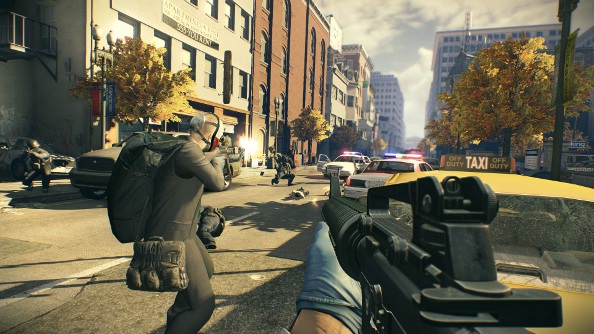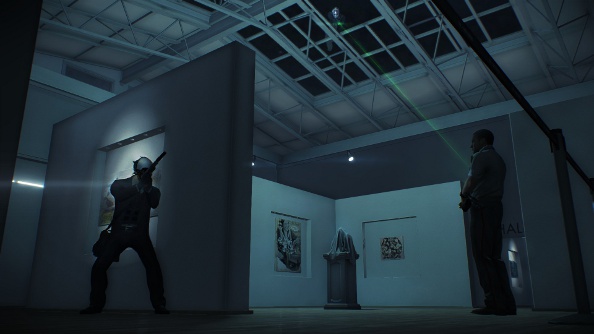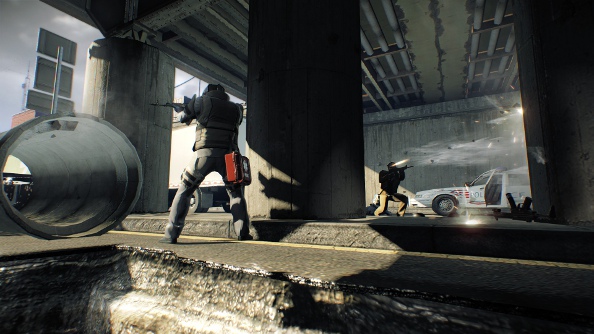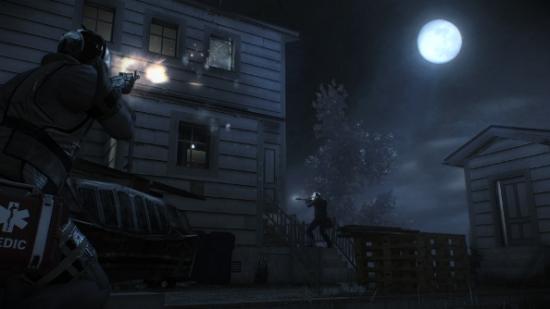David Goldfarb is still angry. Whipcord-thin, with an almost-sallow complexion here on this last day of E3, he fairly crackles with nervous energy that’s constantly on the verge of collapsing into deep fatigue. He’s fighting jetlag, days of interviews and demos, and probably weeks of hard work getting his team’s game ready for E3. That work is being rewarded. Judging by the crush of people trying to play it, Payday 2 is shaping up to be a smash hit.
Goldfarb is directing Overkill / Starbreeze on their follow-up to the cult-hit, Payday: The Heist. Where The Heist was simply a Heat-meets-Left4Dead co-op shooter, the sequel is a far more ambitious design, revolving around character classes, skill trees, and incredibly complicated robberies. It’s practically taken over the meeting room that publisher 505 have rented out above the show floor, the demo stations are constantly jammed, and journalists are beating a path to his door to get interviews.
And yet. Despite Goldfarb’s obvious pleasure in how the game is being received, there’s a restless, dissatisfied air about him. But even as he savors today’s victory, he’s still smarting from the defeats that eventually drove him away from his home at DICE and the Battlefield franchise he used to love.
“I wasn’t happy with the direction of Battlefield 4. I wasn’t happy at the studio any more,” he says, shaking his head. “It was too big. I didn’t feel like we were doing anything interesting, in a real way. And you couldn’t do anything interesting in a real way, because there’s so much money riding on it. And I’d always wanted to make a bank robbery game, and I always wanted to make an RPG. So I kind of was just like, ‘Look, I just want to make the Dark Souls heist game. Can I make that?’”
Goldfarb was the lead on Battlefield: Bad Company 2 and then on Battlefield 3 before leaving DICE to work at Overkill on Payday. In between those three games is the end of a career in AAA mainstream development and the double-edged nature of success in the games industry. That history is also another reason I’m so excited for Payday 2.
Bad Company 2 is the game that ruined Battlefield 3 for me. To this day it seems more exotic, braver, and vastly more enjoyable. The level of destruction on its maps meant that they were almost unrecognizable at the end of a battle from what they had been at the start. The campaign was more light-hearted and memorable compared to a lot of the 24-derived paranoid militarist panegyrics. I don’t think I ever quite managed to forgive Battlefield 3 for not building on that foundation more.
Neither did Goldfarb. After we talk a bit about the two games, he admits, “I adore Bad Company 2. I felt so good about that game. I was lead on Battlefield 3, and I didn’t feel good about that game. We adored Bad Company 2, we sold 15 million units. I’m still bitter. I’m still angry.”
A little anger is probably a good thing in a man who considers this his “punk rock” moment after years of cranking out safe pop hits. Payday 2 itself isn’t an entirely laid-back game, either. There is a pissed-off, post-Occupy tone to the action and the marketing, as the Payday crew take down scores in and around Washington, D.C, laying waste to a political and capitalist class that have prospered in a time of recession.

“It’s an anti-capitalist fantasy,” Goldfarb said. “Even though the banks aren’t really responsible for the fact that the world is completely fucked up, the bankers certainly are. I think there’s such a wellspring of bad sentiment that we’d like to allow people to take out their fantasies. We do try to keep it humorous so it’s not completely about murdering people. But that’s something we are kind of poking at: ‘These are the people that fucked you over. Don’t you want to do something about it?’ And then you’re like, ‘I would love to rob a bank.’”
There’s a lot to love about it. Where the first Payday was purely about shooting it out with the cops and then making an escape, Payday 2 is careful to allow players to take different, more subtle approaches than the guns-blazing assault. If you’re good enough, coordinated enough, and bring the right mix of character classes into the mission, you might be able to walk in and out of a heist job without firing a shot.
“In the first game you didn’t really have other ways of accomplishing the mission. But in this, someone can ECM (electronic countermeasure) the camera, somebody could cap the camera. So it’s more like where we’ve expanded the variety of ways to accomplish the same set of tasks,” Goldfarb explains.

Over our shoulder, a heist is in the process of going badly wrong on a demo station. The alarm sounds and suddenly bank guards and robbers and exchanging fire at point-blank. Goldfarb points a finger at them.
“If those guys were successfully stealthing, they would knock out the guard, and maybe his pager would ring. They could answer his pager and be like, ‘Yeah, just a weapons malfunction.’ And put the pager back down. And they could do that twice before they started getting really suspicious. There’s all this complexity. It will take people awhile to see that’s all happening. Civilians can make phone calls to the cops, so you you gotta control the crowd.”
But to pull off a job correctly, you need to have a good plan and the right mix of characters. Goldfarb is intensely curious to see how people approach Payday 2’s (roughly) 30 missions, and the Pro versions of those missions, and all their map variations and changing objectives.
“It actually makes my head hurt, thinking about how many variants and how much content there is. It’s very, very big,” Goldfarb sighs, rubbing his temples. “But that’s one of the coolest things about what we’ve done. We struggle to pull a lot of these things off. People are going to be searching for the perfect build. ‘Maybe we should take four technicians in there, have everybody lay down sentry guns everywhere, or go in with two or three guys who are masterminds, with one ghost. The Ghost ECMs the cameras and the masterminds are crowd-controlling everyone in the room and they get the vault open. That stuff is fucking awesome! We don’t actually know what’s going to happen!”

Those classes all have their own skill trees, and as players develop their characters, they are also finding new weapon add-ons and upgrading their heisting equipment. In addition to that, there is something on the order of 15 million possible variations to the robbers’ masks. But the masks consume item drops as players make them, so you can’t mix and match materials and patterns. Once you commit to a mask, the components are gone for good.
The character progression is similarly choice-driven, although its implications go far beyond the cosmetic. It’s an important part of Goldfarb’s design philosophy.
“I hate games that give you everything, and you’re just following a curve and the curve ends. In the case of the skill tree, you can only invest a certain amount of points, for 75% of the skill trees, you won’t have enough points to invest in them. So I think for me it’s critical that we negate that so that people can’t have everything because it’s the same with weapon mods.”
Goldfarb pauses, and some of that anger resurfaces. Goldfarb talks about Payday 2 like it’s part of an argument, not just with EA, but with much of modern game design. “We’ve tried to make sure that there is none of that situation like in an EA game… or someone like EA. Where you’re just looking for the best car, or you’re looking for the end of the progression. This is made like Diablo 2. [Abilities and trees] are supposed to have offsets. Then you make the choice.”
